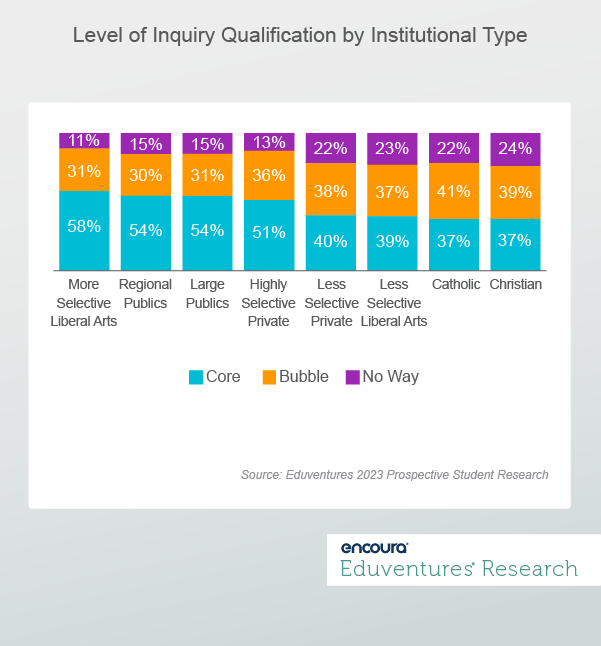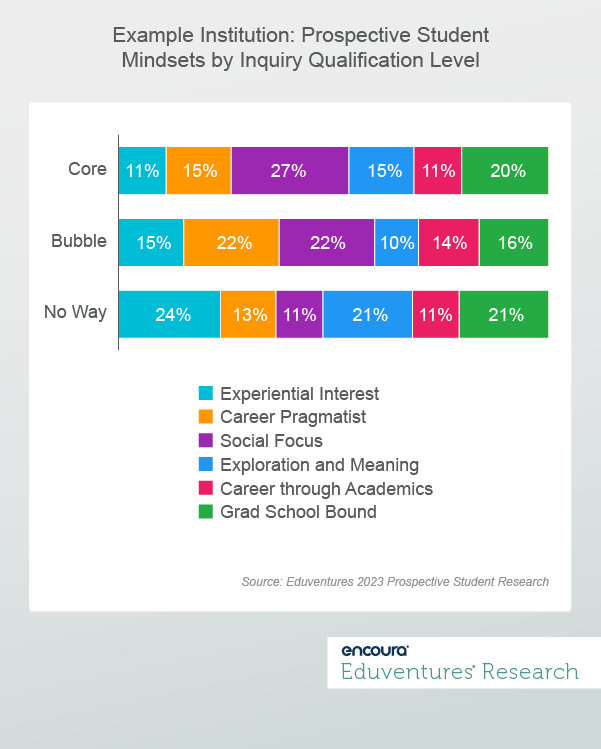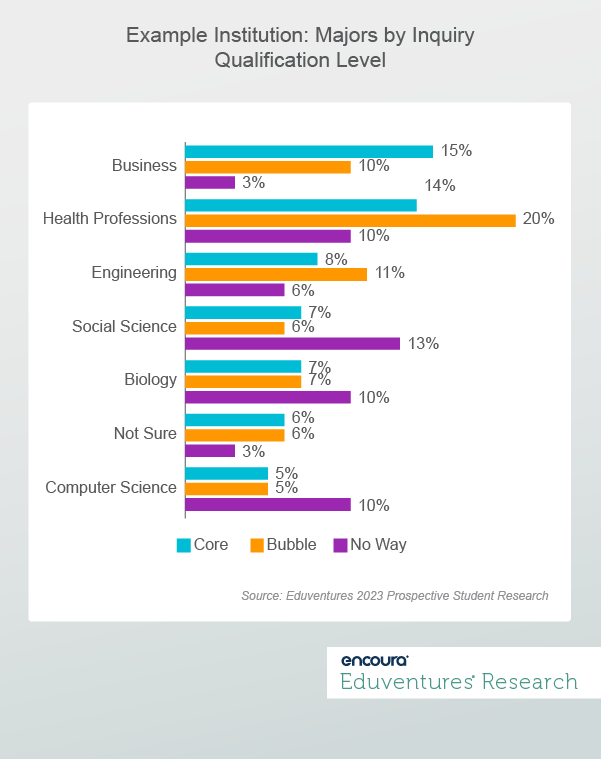Which students are in love with your school? And which students are merely in like with your school?
These are two basic questions that every institution should be asking about its inquiry pool.
This understanding is necessary to develop effective top-of-the-funnel marketing, communications, and recruiting strategies that move students to apply. Below are six steps every institution must take to motivate students “on the bubble” and more insights on who those students are.
Core, Bubble, and No Way Students
Eduventures’ Prospective Student Research™ allows us to qualify institutional inquiries into different levels of interest. For about 100 institutions, we’ve asked students how likely they were to apply to the host institution.
We define “Core” students as those who applied or were extremely likely to apply; students are certain about application. “Bubble” students are those who are somewhat likely or somewhat unlikely to apply; students are uncertain, but still in the mix.
And “No Way” students are those who are unlikely to apply; students are almost certain they won’t apply. Figure 1 shows the qualification rates for the different kinds of institutions.

According to Figure 1, most institutions have a substantial number of students on their inquiry lists. There is greater interest (Core or Bubble) than disinterest (No Way). But qualification levels vary across different types of institutions. For example:
- More selective liberal arts institutions have the highest percentage of inquiries who are certain about applying (58% Core).
- Religiously affiliated institutions, on the other hand, face challenges building a highly qualified inquiry list. Only 41% of Catholic and 39% of Christian institution inquiries qualify as Core students. This underscores the difficulty of attracting students unsure about their religious affiliations.
No matter in which kind of school you work, the differences in qualification levels are instructive for your enrollment strategy, especially the difference between Core students and those on the bubble. Bubble students are curious and by addressing their curiosity, you can move them to apply.
Case Study: Mind the Gap
Here’s an example of what this looks like for a large public institution examining its out-of-state inquiries. Figure 2 shows the Prospective Student Mindsets™ (Mindsets) of out-of-state inquiries by inquiry qualification level.

This institution’s Core out-of-state inquiries are Social Focus (27%), and to a lesser extent, Grad School Bound (20%). Students on the bubble, however, are more likely to be Experiential Interest (15%) and Career Pragmatists (22%). No Way students are far less Social Focus (11%) and far more Experiential Interest (24%).
This means that students who are curious, but not convinced, lean a little bit more pragmatic, but they’re still quite social. The institution is less attractive to students who are experientially oriented. They also compete strongly with other institutions for Grad School Bound students.
Further analysis reveals that there are very important differences in academic major interests between qualification levels (Figure 3).

Figure 3 shows that the example institution’s core out-of-state students have a much stronger interest in business (15% Core vs. 10% Bubble, 3% No Way). For those on the bubble, health professions and engineering are critical.
There are some other key differences between Core and Bubble students in this example:
- Demographics: 33% of Bubble students are first generation college students (vs. 23% Core). Bubble students are also most likely to report household income of less than $50,000 (30% vs. 19% Core, 24% No Way).
- Ability to Pay: 44% of Core students and 46% of No Way students say their parents or guardians will pay for most or all of their education costs (vs. 31% Bubble). Historically, underserved students are more likely to be on their own. This means they are necessarily less certain about their college choices and prospects – particularly in this out-of-state example. Improving affordability is key to moving those students from application to inquiry.
In summary, this picture reveals complexities in the inquiry pool. Core out-of-state students are highly social or focused on graduate school. They lean strongly toward business as a major and have more resources.
Students on the bubble are less social and more career focused. They are interested in health professions and engineering and have fewer resources.
To reach Bubble students, this institution must focus on career-focused messages in the right majors and be transparent about affordability. It might need to find more financial support for out-of-state students to truly improve inquiry-to-application conversion rates.
The Bottom Line
How do you cut through the fog when working with an extensive inquiry list? Remember that the students on the bubble matter the most. Students who love you will apply, but convincing the indifferent ones can be challenging. Targeted communications can move students on the bubble.
Here are six steps to transition them from prospects to applicants:
- Understand which students love you and which students like you. Refine communications to persuade the curious but uncommitted.
- Identify Mindsets and majors that reflect your core brand. This is crucial for effective communication and success.
- Identify Mindsets and majors just outside of your core identity. Curious students may have interests where your strength is uncertain.
- Understand the demographic challenges faced by students on the bubble. First-gen, low-income, or underrepresented students may have concerns beyond affordability. Students with strong academic credentials could be looking elsewhere due to reputational issues.
- Craft targeted messaging for key majors appealing to students on the bubble. Develop targeted communications and recruitment plans focusing on the majors, Mindsets, and competitive set of students on the bubble.
- Assess affordability and financial support. Ensure Bubble students feel comfortable applying by offering realistic options.
Never Miss Your Wake-Up Call
Learn more about our team of expert research analysts here.
Eduventures Principal Analyst at Encoura
Contact

